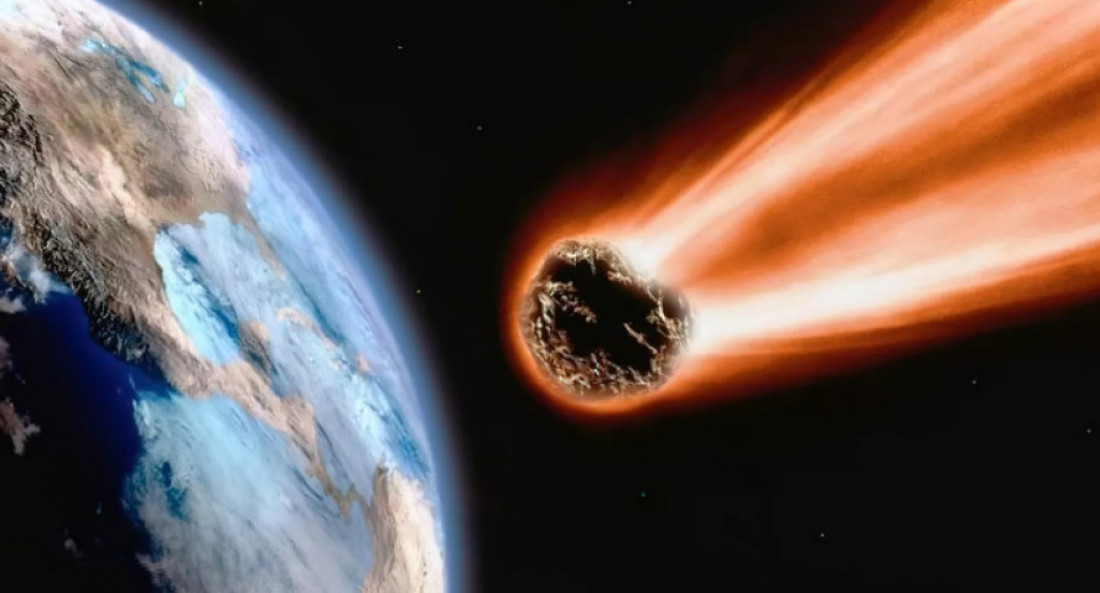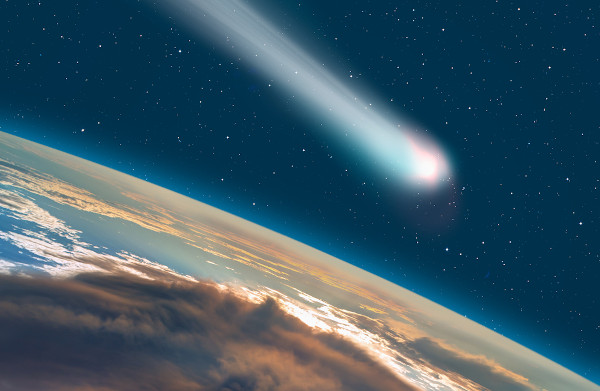Delving into the cosmic depths, the majestic spectacle of comets streaking across the night sky has long captivated human interest. These celestial bodies, seemingly gentle yet bewilderingly enigmatic, are more than just astronomical wonders. They are invaluable time capsules offering clues to the early solar system, and perhaps even the origins of life itself. In this exploration, “Unveiling the Mysteries of the Cosmos: Exploring the Enigmatic Origins of Comets” presents an in-depth analysis of these icy travelers and their mysterious roots.
As we journey through the vast expanse of space, our focus shifts towards the birthplace of these icy entities – the distant realms of our solar system. Over billions of years, comets have embarked on interstellar journeys, their paths illuminated by the Sun, casting ethereal light shows across the cosmos. Their origins, wrapped in a shroud of cosmic mystery, provide an intriguing focal point for scientists and space enthusiasts alike.
Beyond their aesthetic appeal, comets carry profound scientific significance. Each icy nucleus is a frozen relic from the past, retaining pristine materials from the primordial cloud that gave birth to our solar system. The exploration and study of these cosmic time capsules offer invaluable insights into our cosmic ancestry and the very processes that led to the formation of planetary bodies.
With the help of modern technology and advanced space exploration tools, we are gradually peeling back the layers of mystery surrounding comets. From the pioneering observations of Halley’s Comet to the groundbreaking data from spacecraft like Rosetta and Philae, the quest to understand these celestial phenomena is a continually evolving scientific saga.
“Unveiling the Mysteries of the Cosmos: Exploring the Enigmatic Origins of Comets” invites you on this intriguing expedition, unraveling the cosmic secrets that these celestial bodies hold. Brace yourself for a celestial odyssey, as we unearth the deep-seated secrets of these icy messengers from the dawn of our solar system. Prepare to navigate the cosmos, where every comet tail points to a new discovery, a new understanding, and a new perspective on our place within the cosmic tapestry.
The Origin of Comets
Comets, often affectionately described as “dirty snowballs,” are fascinating cosmic entities predominantly composed of water ice, interstellar dust, frozen gases, and organic compounds. These celestial wanderers drift silently through the solar system, occasionally captivating observers with their luminous tails as they approach the Sun. Despite centuries of observation, comets still hold many secrets, particularly regarding their mysterious origins. Scientists widely acknowledge that these enigmatic objects are pristine remnants from the earliest epoch of our solar system, meticulously preserved in the distant, icy regions known as the Kuiper Belt and the Oort Cloud. Yet, precisely how these icy relics formed and found their way to the solar system’s outskirts remains shrouded in uncertainty.

The most widely accepted explanation for the origin of comets is rooted in what is known as the Nebular Hypothesis. This compelling theory posits that comets—and indeed all celestial bodies in our solar system—were formed roughly 4.6 billion years ago, during the chaotic and dynamic birth of the Sun. According to this hypothesis, our solar system began as a vast, cold, rotating cloud of gas and dust, primarily composed of hydrogen and helium, with trace amounts of heavier elements and organic materials. Over time, gravitational instabilities within this immense nebular cloud caused regions of denser material to collapse inward, initiating a spiraling motion. As the collapsing cloud accelerated, it flattened into a rotating, disk-shaped structure known as the protoplanetary disk.
Within this protoplanetary disk, countless microscopic particles of dust and ice began colliding and gradually adhering to one another, forming progressively larger clumps of material. Initially, these tiny accumulations, known as planetesimals, ranged from mere centimeters to several kilometers in diameter. Over millions of years, some planetesimals coalesced into planets, moons, and asteroids due to gravitational attraction, while others remained relatively small and untouched. These leftover icy planetesimals, too small and distant to merge into larger celestial bodies, became the building blocks of comets. As the massive outer planets—Jupiter, Saturn, Uranus, and Neptune—formed, their powerful gravitational fields began scattering many of these cometary precursors into far-flung orbits, casting them outward into the distant reaches of our solar system.
In the deep, cold reservoirs beyond Neptune, such as the Kuiper Belt, and even further out in the hypothetical Oort Cloud, these cosmic snowballs have remained preserved for billions of years, essentially unchanged since the early solar system. Because of their pristine preservation, comets represent invaluable cosmic archives, storing information about the original composition and conditions of the nebular cloud that eventually led to the formation of the planets and the Sun itself.
However, despite the elegance of the Nebular Hypothesis and its widespread acceptance, significant mysteries persist. For instance, scientists continue to question exactly how cometary materials were transported to their current locations. Were these objects gently nudged into distant orbits over millions of years, or were their placements violent and chaotic, driven by cataclysmic gravitational interactions? These unanswered questions fuel ongoing scientific investigations, driving humanity’s quest to unravel the true cosmic origins of these captivating celestial visitors.
Protoplanetary Disk and the Formation of Comets
The protoplanetary disk is crucial in the formation of comets. It is in this disk where dust and ice particles started to combine, forming larger and larger clumps. When these clumps grew to a certain size, their gravitational pull became stronger, attracting more particles and leading to the creation of planetesimals – the building blocks of planets.
It is hypothesized that comets are made of the same materials as these planetesimals, but unlike planetesimals, comets never grew large enough to become planets. Instead, they were flung to the outer reaches of the solar system by the gravitational influence of the newly formed giant planets.
Composition of Comets
Understanding the composition of comets is fundamental to unveiling their enigmatic origins. Comets, often perceived as ethereal celestial visitors, are actually complex cosmic bodies composed of an intriguing blend of materials. Primarily, they consist of water ice intermixed with frozen gases such as carbon dioxide (dry ice), methane, ammonia, and carbon monoxide, accompanied by dust particles and organic compounds. This diverse chemical composition vividly illustrates the frigid and remote environments where comets initially formed.
At the heart of each comet lies its nucleus, typically only a few kilometers in diameter. This nucleus is essentially a compact conglomeration of ice and dust—commonly referred to as a “dirty snowball”—held together by gravity and intermolecular forces. When comets journey close to the Sun, solar radiation heats their icy cores, causing volatile substances to sublimate directly from ice to gas, releasing trapped materials into space. This process produces a vast, luminous atmosphere around the nucleus known as the coma, composed of gas, vaporized ice, and entrained dust.

The dust grains within comets are especially significant, as they offer scientists valuable insights into early solar system chemistry. Analyses of cometary dust samples collected by spacecraft missions such as NASA’s Stardust revealed a surprisingly diverse range of minerals and organic molecules. These discoveries suggest that comets are not only remnants from the early solar system but could also have played a pivotal role in delivering organic materials—potential building blocks of life—to planetary surfaces like the early Earth.
By examining comet compositions, scientists effectively peer back in time, reconstructing conditions prevalent during the solar system’s infancy. Each comet thus serves as a preserved cosmic archive, rich with data about the primordial cloud from which our planetary neighborhood emerged, making the study of their composition essential for unraveling our cosmic history and the enigmatic story of life itself.
The Nucleus and the Coma
The core of a comet, known as the nucleus, is a solid body composed mainly of ice and rock. Typically irregular in shape and resembling an icy asteroid, the nucleus contains ancient materials preserved since the formation of the solar system. When a comet gets close to the Sun, increasing solar radiation warms the icy surface, causing ice to sublimate directly from a solid to gaseous state. This sublimation process releases vast amounts of gas and dust, forming a luminous, expansive cloud around the nucleus, known as the coma.

Observing the coma provides valuable insights into the comet’s composition. For instance, the detection of organic molecules in the coma of comets like Halley and Hale-Bopp supports the idea that comets could have played a significant role in delivering water and organic material to the early Earth, possibly contributing to the origin of life. This discovery underscores comets’ potential importance as carriers of essential building blocks necessary for life, offering a tantalizing glimpse into the complex interplay between cosmic events and the emergence of life on our planet. Consequently, studying the nucleus and coma of comets continues to enhance our understanding of how life-supporting molecules were distributed throughout the solar system.
The Oort Cloud and the Kuiper Belt
The Oort Cloud and the Kuiper Belt are the two primary reservoirs of comets in our solar system. The Kuiper Belt is a ring of icy objects located just beyond the orbit of Neptune, while the Oort Cloud is a spherical shell of icy bodies located in the distant outermost region of the solar system.
The Kuiper Belt Objects (KBOs)
The Kuiper Belt Objects (KBOs) are thought to be remnants of the early solar system. These bodies are largely composed of ices, similar to comets, and are believed to be the source of short-period comets – comets with orbits that take them around the Sun in less than 200 years.
The Oort Cloud Comets
The Oort Cloud is believed to be the source of long-period comets, comets that take more than 200 years to orbit the Sun. The existence of the Oort Cloud is not yet confirmed, as it is too distant to be directly observed with current technology. However, the observation of long-period comets coming from all directions in space supports the existence of this distant reservoir of comets.
Exploring Comets
The study of comets has significantly evolved with advancements in technology, enabling us to explore these objects directly. Spacecraft missions like NASA’s Stardust and European Space Agency’s Rosetta have provided detailed observations of comets, collecting valuable data that help us understand the conditions of the early solar system.
NASA’s Stardust Mission
NASA’s Stardust mission, launched in 1999, was the first mission to return a comet sample to Earth. The mission collected particles from the coma of Comet Wild 2 and returned them to Earth for analysis. This mission revealed a surprising diversity of mineral compositions in the comet, suggesting a complex history of the early solar system.
European Space Agency’s Rosetta Mission
The Rosetta mission, launched by the European Space Agency in 2004, marked another milestone in comet exploration. Rosetta orbited Comet 67P/Churyumov–Gerasimenko for two years, studying its nucleus, coma, and tails. It also deployed a lander, Philae, on the comet’s surface, the first time a spacecraft has ever landed on a comet.
Conclusão
In conclusion, the exploration of the enigmatic origins of comets is a captivating journey that unravels the mysteries of the cosmos. Through modern technology and innovative research, scientists have been able to delve deeper into the celestial realm, shedding light on the primordial history of our universe. Comets, often dubbed as ‘dirty snowballs’, serve as cosmic relics that hold within them the raw materials of our universe’s infancy. Their examination offers invaluable insights into the fundamental processes that led to the formation of planets, galaxies, and life as we know it.
However, despite the strides made, the genesis and nature of comets still largely remain a puzzle, cloaked in ambiguity. Yet, this very mystery fuels the desire to uncover more, to look beyond the known, and to journey into the cosmic wilderness. The study of comets is not merely about understanding these celestial bodies, but it is an endeavor to answer deeper existential queries about our origins, our universe, and ultimately, our place within it. Indeed, the journey of exploring the mysteries of the cosmos is as much an outward expedition as it is an inward introspection.
In the grand scheme of things, the quest for understanding the enigmatic origins of comets is an affirmation of our enduring curiosity, our relentless pursuit of knowledge, and our ceaseless journey towards unveiling the mysteries of the cosmos.



